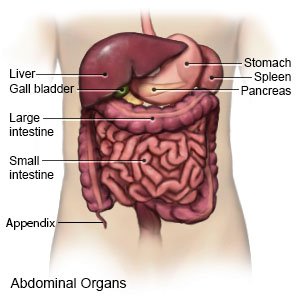Tips (Transjugular Intrahepatic Portosystemic Shunt)
Medically reviewed by Drugs.com. Last updated on Aug 4, 2025.
A transjugular intrahepatic portosystemic shunt (TIPS) is a channel made inside your liver to increase blood flow. The shunt reduces swelling in your abdomen, and lowers portal hypertension. TIPS may also reduce fluid buildup in your abdomen.
 |
WHILE YOU ARE HERE:
Before your procedure:
- Informed consent is a legal document that explains the tests, treatments, or procedures that you may need. Informed consent means you understand what will be done and can make decisions about what you want. You give your permission when you sign the consent form. You can have someone sign this form for you if you are not able to sign it. You have the right to understand your medical care in words you know. Before you sign the consent form, understand the risks and benefits of what will be done. Make sure all your questions are answered.
- An IV is a small tube placed in your vein that is used to give you medicine or liquids.
- General anesthesia may be given to keep you asleep and free from pain during your procedure. You may get anesthesia through your IV or as a gas through a mask or a tube placed down your throat. The tube may cause you to have a sore throat when you wake up.
During your procedure:
- Your healthcare provider will insert a needle into your neck, and guide it into your jugular vein. Your jugular vein is a main vein in your neck that helps drain blood from your head. It leads all the way down to your liver. Your provider will open the vein wide enough to insert a small catheter and stent (tube) into it. The stent is the covered tube that will be placed in your liver to create the path between the 2 main veins. Your provider will inject contrast liquid and use x-rays, an ultrasound, or venography as a guide to know where to place the catheter.
- Your provider will use a small balloon attached to the catheter to measure blood pressure in your veins. Vein pressure will also show him or her where to place the TIPS inside your liver. Your provider will then insert the catheter into your liver. He or she will inflate the balloon when it is placed between the 2 main veins in your liver. The balloon will make a channel for the stent.
- Your healthcare provider may repair bleeding areas in your esophagus before or after the TIPS procedure. He or she will then place a bandage on the small wound on your neck.
Related medications
After your procedure:
- You will be taken to a recovery area where healthcare providers will watch you until you are alert. Do not get out of bed until your healthcare provider says it is okay.
- You may need an ultrasound 2 to 3 days after your procedure to make sure the stent and shunt are working well. You may also need a test called a venogram to check blood flow through the veins in your liver. You will need another ultrasound 1 to 4 weeks after your procedure.
RISKS:
- Rarely, a blood vessel or organ may be damaged during the procedure. This may cause bleeding inside your body. After your procedure, the stent could narrow and cause blood clots to form inside the stent. This may block blood flow, or increase blood pressure in your veins. The stent may move out of place or stiffen and stop working. You may also be at risk for a blood infection called sepsis. You may have new or worsened encephalopathy after your procedure. Encephalopathy is brain damage that causes mood and behavior changes. Your procedure may not reduce your portal hypertension. This means the bleeding in your esophagus and swelling in your abdomen may not stop. These problems may be life-threatening.
- You may need to receive another TIPS procedure if your stent has slipped or is not working. You may also need another TIPS procedure if the stent does not reduce your portal hypertension or other symptoms. You may have heart failure from the increased blood flow to your heart after your procedure. This procedure may not improve your chance for survival. The TIPS procedure may cause liver failure. You may still need a liver transplant after a TIPS procedure.
CARE AGREEMENT:
You have the right to help plan your care. Learn about your health condition and how it may be treated. Discuss treatment options with your healthcare providers to decide what care you want to receive. You always have the right to refuse treatment.© Copyright Merative 2025 Information is for End User's use only and may not be sold, redistributed or otherwise used for commercial purposes.
The above information is an educational aid only. It is not intended as medical advice for individual conditions or treatments. Talk to your doctor, nurse or pharmacist before following any medical regimen to see if it is safe and effective for you.
Further information
Always consult your healthcare provider to ensure the information displayed on this page applies to your personal circumstances.
